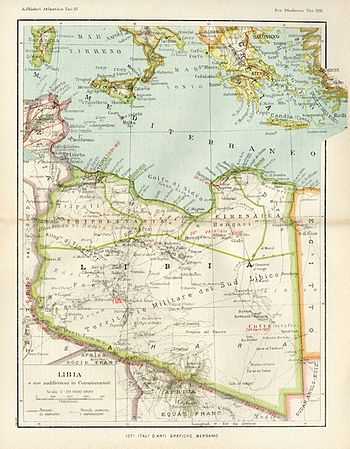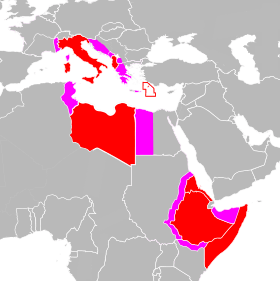Italian North Africa
| Italian North Africa | ||||||
| Africa Settentrionale Italiana | ||||||
| Colony of Italy | ||||||
| ||||||
| ||||||
Italian North Africa in 1940 Green: Italian North Africa Dark grey: Kingdom of Italy Grey: Other Italian possessions and occupied territories | ||||||
| Capital | Tripoli | |||||
| Languages | Arabic, Italian | |||||
| Religion | Islam, Roman Catholicism | |||||
| Political structure | Colony of Italy | |||||
| History | ||||||
| - | Established | 1911 | ||||
| - | Disestablished | 1943 | ||||

Italian North Africa (Africa Settentrionale Italiana, or ASI) was the aggregate of territories and colonies controlled by Italy in North Africa from 1911 until the Second World War: Italian Libya and Italy occupied Tunisia after November 1942, with the temporary occupation of western Egypt during some periods of the war.
Brief history
Italian North Africa, unlike Italian East Africa (Africa Orientale Italiana, or AOI) existed in two phases: from 1911 to 1934, as Tripolitania and Cyrenaica, and after 1934, as Libya (with the later addition of coastal Tunisia during the Second World War. From 1934 to 1939, all of Italian North Africa was then known as Libya, as the North African territories were consolidated into one colony, Italian Libya. In 1939 the Italian dictator Benito Mussolini called coastal Libya the Fourth Shore (Quarta Sponda) of Italy and it was united with metropolitan Italy.
The term "Fourth Shore" derives from the geography of Italy being a long and narrow peninsula jutting into the Mediterranean with two main shorelines, the First Shore on the east along the Adriatic Sea and the Second Shore on the west along the Tyrrhenian Sea. The third shore was the one facing south, to the Ionian sea and central Mediterranean (from Cape Leuca in the southern tip of Apulia, to the southern shores of Sicily near Trapani). The Adriatic Sea's opposite southern Balkans shore, with Dalmatia, Montenegro, and Albania, was planned for Italian expansion as a possible Fifth Shore, with Libya on the Mediterranean Sea remaining as the Fourth.[1] Thus the Fourth Shore was the southern part of Imperial Italy, an early 1940s Fascist project of enlarging Italy's national borders around the Italian Mare Nostrum.
From 1940 to 1943, during the Second World War, following Italy's declaration of war on Britain and France, it attempted to conquer Egypt and Tunisia to enlarge Italian North Africa. Indeed, the Axis's military advances led by Rommel in North Africa allowed Italy to lay claim to significant portions of western Egypt: Italian fascists anticipated creating a client Kingdom of Egypt under Italian control from 1941 to 1942 and successively claimed Tunisia from 1942 to 1943.
After Italy's poorly conducted yet still successful invasion of southern France, Mussolini demanded Tunisia, along with Djibouti, Corsica and Nice from France.[2] However it wasn't until November 1942 that Italian troops seized Tunisia, with German Field Marshal Rommel's Afrika Korps troop support, from the French Vichy regime colonial administrators.
Tunisia was added administratively to the existing northern Italian Libya Fourth Shore, in Mussolini's last attempt to accomplish the fascist project of Imperial Italy.[3] In the first months of 1943 were opened Italian schools in Tunis and Biserta, while 4000 Italian Tunisians volunteered in the Italian Army.
In the last months of 1942 some Tunisians and local Italians did even join the National Fascist Party in Tunis. From December 1942 until February 1943 Tunisia and Italian Libya were under Italian control and administered as "Africa Settentrionale Italiana",[4] but later the Allies conquered all Italian Tripolitania and Italian control was reduced to the Tunisian area west of the Mareth Line (where was fought a last Axis stand).
All legally established territory of Italian North Africa was dissolved by early 1943, but Tunisia remained the last de facto Italian administered territory until all Tunisia fell to American and British forces. In May 1943 the Allies' victorious Tunisia Campaign (1942—1943), part the Western Desert Campaign, regained all the Tunisian territory for France. The French colonial authorities then closed all Italian schools and newspapers.[5]
Colonies and territories within Italian North Africa
From 1912 to 1927, Italian North Africa (Italian Tripolitania and Italian Cyrenaica) was an entity to itself, and from 1934 to 1941, Italian North Africa was united into the single colony of Italian Libya. But in 1939 coastal Italian Libya was added to metropolitan Italy, while Saharan Italian Libya remained as a colonial territory under military control.
From 1942 to 1943 Tunisia was added, and was administered as part of the Fourth Shore of Italy. Military units of Italians of Tunisia were created, because 4000 Italo-Tunisians volunteered to fight in the Italian Army. One was called Reggimento Volontari Tunisini dell'Africa Settentrionale Italiana[6]
1927–1934
1934–1941
- Italian Libya. In 1939, Benito Mussolini coined the name Fourth Shore, in Italian Quarta Sponda, to refer to coastal Italian Libya in Italian North Africa (later he added coastal Tunisia during WWII).
1941–1943
- Italian Libya
- German and Italian occupied western Egypt (from 1940 to 1942 in some periods)
- German and Italian occupied Tunisia (from 17 November 1942 to 13 May 1943)
See also
- Italian Empire
- Fourth Shore
- History of Libya as Italian Colony
- Italian Libya
- Italian Cyrenaica
- Italian Tripolitania
- Military Territory of the South (Italian Libya)
- History of Libya
- History of Egypt
- History of Tunisia
- Italian East Africa
Notes
- ↑ Moore, Martin (1940). Fourth Shore: Italy's Mass Colonization of Libya African Affairs XXXIX (CLV), p. 129-133.
- ↑ Mussolini, Benito; Child, Richard Washburn; Ascoli, Max; Lamb, Richard (1998). Ascoli, Max, ed. My rise and fall. Da Capo Press. ISBN 978-0-306-80864-7.
- ↑ Knox, MacGregor (1986). Mussolini Unleashed, 1939-1941: Politics and Strategy in Fascist Italy's Last War. Cambridge University Press. p. 138. ISBN 0-521-33835-2.
- ↑ Ezio Gray. "Le nostre terre ritornano..." Introduzione
- ↑ Watson, Bruce Allen Exit Rommel: The Tunisian Campaign, 1942-43 p. 103
- ↑ Reggimento Volontari Tunisini
Bibliography
- Battistelli, Pier Paolo. Italian Army Elite Units & Special Forces 1942-43. Osprey Publishing. New York, 2011 ISBN 1849088950
- Gray. Ezio. Le nostre terre ritornano...Malta, Nizza, Corsica.... Ed. De Agostini. Novara, 1943
| ||||||||||||||||||||||||
| ||||||||||||||||||||||||||||||||||||||||||||||||||||||||||||||||||||||
.svg.png)
.svg.png)

